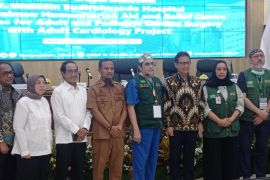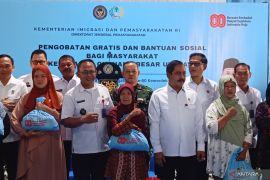"The number of TPT in Indonesia is quite low, never more than 10 percent of the target. If the therapy is not given adequately, our efforts to eliminate tuberculosis in the country will not be achieved although we have found and treated all patients," Head of Sub-Directorate of Tuberculosis of the ministry, Imran Pambudi, stated during a discussion at the National Tuberculosis Partnership Forum on Wednesday.
Pambudi remarked that TPT is an alternative approach to eradicate tuberculosis in Indonesia, and this therapy should be applied to populations at risk, including children under five, who have close contact with active pulmonary tuberculosis patients, and people with HIV/AIDS. In 2024, the government has set a target to provide TPT to 1.1 million people at risk.
Meanwhile, tuberculosis cases are estimated to have reached around 9.96 million cases globally, with 6.17 million of them being male patients.
Indonesia is included in eight countries in the world that constitute two-thirds of the global tuberculosis cases. Indonesia ranks second after India, with an estimated number of cases reaching 845 thousand and deaths recorded at 98 thousand per year. Out of the figure, 349,549 cases are estimated to be notified, with treatment services, at 41.4 percent, and a cure rate of 84.4 percent.
Out of the total tuberculosis cases in Indonesia, 8,060 cases are estimated to be of drug-resistant tuberculosis, a condition in which Mycobacterium tuberculosis has developed immunity to Anti Tuberculosis Drugs.
Pambudi explained that the number of tuberculosis cases had spread across 34 provinces in Indonesia, with the largest number of cases last year being in West Java, East Java, Central Java, DKI Jakarta, and North Sumatra. Meanwhile, the disease mostly affects people in the productive age group.
By 2024, the government is targeting to reduce the incidence of tuberculosis to 190 per 100,000 population and a reduction in the death rate due to the disease to 27 per 100,000 population.
To achieve this target, the government has applied several strategies, including by strengthening program leadership at the central, provincial, and district/city levels.
Moreover, Pambudi emphasized that local governments played a crucial role in tackling cases of tuberculosis.
"No matter how good the program is implemented by the central government, the program will fail if the local government does not realize it," he pointed out.
Another strategy is to increase access to quality and patient-friendly tuberculosis treatment services, step up promotion and prevention, treatment delivery, infection prevention and control, and also capitalize on research results and technology for screening, diagnosis, and treatment of tuberculosis.
In addition, collaboration with communities, partners, and multiple sectors is deemed important, including efforts to strengthen the health system to bolster program management. Related news: Indonesia set to forge forward in TB handling amid COVID-19 pandemic
Related news: Only 24% tuberculosis patients have accessed health service facilities
EDITED BY INE
Translator: Nanien Yuniar, Katriana
Editor: Suharto
Copyright © ANTARA 2021












